StarCruiser
Comments by Marcus Lindroos, thanks to David Jefferis
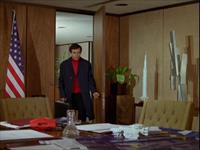
The Starcruiser only appears as a desktop model in the additional scenes of the Alien Attack compilation, filmed in 1979. One might surmise that the model depicts a proposed future spacecraft design that had not necessarily been approved by the International Lunar Finance Commission at that point.
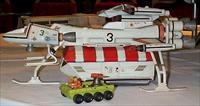
In reality, Starcruiser was proposed at the end of 1975 by Gerry Anderson and Fred Freiberger to the American CBS network. They were developing 3 different projects, Starcruiser, Rescue 4 and a second series of Space: 1999, all for the 1976 season. CBS declined the series, and instead Anderson and Freiberger made the second series of Space: 1999. Towards the end of 1976, as Space: 1999 completed filming and faced cancellation, Gerry Anderson and his business partner Keith Shackleton decided to use Starcruiser for toys and a comic strip. The comic strip was the first to appear, in January 1977 in the weekly Look-In comic. At the end of 1978, Airfix produced a plastic model kit. The comic strip lasted until 1979; the Airfix kit was produced until 1984.
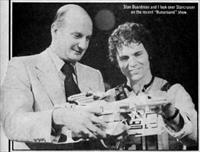
In early 1978, Gerry Anderson appeared on the children's game show Runaround and showed the model of Starcruiser to presenter Stan Boardman (wearing an Alphan spacesuit).
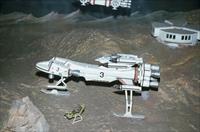
The Starcruiser prototype model was made by Space:1999 modelmaker Martin Bower.
Starcruiser model was a small modular craft capable of faster-than-light interstellar travel. It extends the concept of the modular Eagle Transporter, with command module, main body, passenger pod and attachments. All the Starcruiser modules are capable of independent operation in space as well as in planetary atmospheres.
In October 1975, Gerry Anderson went to Los Angeles to recruit an American head-writer for the proposed second series of Space: 1999. He found Fred Freiberger and they agreed to work together in mid-October. They began to work on concepts for the second series, as well as other series proposals.
One was Rescue 4 for NBC. The other was Starcruiser for CBS. Both were live action, with 13 half-hour episodes, with options for additional episodes. Both series were intended for autumn 1976, and the development work was likely done in November/December 1975 and January 1976, before Space: 1999 year 2 started. Starcruiser seems to be an update of the format for Into Infinity, produced by Gerry Anderson in 1975, which also had a family exploring space.
Gerry Anderson is quoted in "What Made Thunderbirds Go!" by Simon Archer and Marcus Hearn (2002): 'I devised an ultra-modern house where a mother, father and two kids lived. At the touch of a button the house would literally fold into a spaceship. The family would travel around the universe from planet to planet, and every time they landed somewhere habitable the house would unfold and they would live there for a few months, have adventures and move on.'
Gerry worked on the scripts from Pinewood and then flew to Los Angeles for the script conferences with CBS. 'I'd fly for 11 hours to attend a conference that would last 15 minutes. It was quite ridiculous.' On one occasion, Freiberger was unhappy with one of the scripts and suggested to Gerry that they reviewed it on his next visit. At the meeting, Freiberger called his wife in and proceeded to dictate a revised script there and then, much to Gerry's annoyance. 'I thought, "What's going on? I'm doing all this work in England and then I come over here and he writes a new script which I don't like." At the end of the day, it really didn't work and we didn't get the deal.'
Only one script is known to exist, and is described by Shaqui Le Vesconte in Andersonic #11 (2011).
The 34 page script titled Run Robot Run featured a family as crew: former athlete John Wilson, his wife Millie and their 2 children, Sandy and Jamie. Both children has special powers, although their origin and limits are unclear. The daughter Jamie can move at "continuum" speed, while son Sandy can run across the ceiling. There is also a parrot named Oscar who squawks phrases like "Red Alert" (an echo of Robbie the Robot from Fireball XL5).
In the story they find another Starcruiser crew on a planet, the paranoid Harry Cartwright who designed the original craft, his daughter Jenny and a robot. Cartwright sends the robot to destroy Starcruiser. They cannot destroy the robot, but Sandy sets holograms of the Starcruiser around it, which it attacks until it flies over a cliff and shatters on rocks below. The planet is destroyed by colliding moons, but Starcruiser and the prototype Cartwright Starcruiser escape.
Freiberger's proposals for revamping Space: 1999 won ITC's backing around the start of December 1975, with the series being announced publicly on 15 December. It is possible both Rescue 4 and Starcruiser were still being pitched as pre-production of Space: 1999 Year 2 continued, although from start December 1975 and especially after filming started on 26 January 1976 the producers needed to be fully committed to the new series.
Previous accounts have suggested Anderson and Freiberger were still proposing the Starcruiser series after Space: 1999 completed, in early 1977. But from late 1976, David Jefferis was preparing the Starcruiser comic strip, to be launched January 1977, and he was given considerable freedom to develop it, with no constraints to use the original TV format or any later ideas. This suggests whatever shows Anderson and Freiberger were pitching were new concepts.
The Look-In strip eventually ran for over 75 weekly issues in 1977-79. It was written and illustrated by David Jefferis. Jefferis worked as an editor producing educational books such as The Usborne Book Of The Future with Kenneth Gatland (1979). The Starcruiser strip was intended to explain science and astronomy as much as tell a story. Look-In was edited by Colin Shelbourn, who was also working as an art director for Usborne Publishing.
David Jefferis was given some black and white photos of Bower's model, and visited Gerry Anderson and Keith Shackleton at Pinewood to discuss the concept (while Anderson was completing filming of Space:1999 year 2). He never saw any TV scripts, and was given the freedom to rework the concept, characters and story around the ship design. The family crew, and parrot, were gone, and the interstellar format was mostly gone too (mostly).
Most of the missions involved the command module separating from the main body (in the Terra Nova story it is lost in quicksand on an alien planet). The laboratory pod (Command Base in the Airfix kit) is detached in several stories. The interceptor ("gunship") was used very rarely.
The Starcruiser crew consisted of pilot David Starr and systems controller Venus Brown. It was set in 2051. There is extensive exploration of the solar system, including asteroid mining. There is a rotating space station that looks exactly like the one from 2001: A Space Odyssey. In one story on Mars they encounter a UFO which gives them a small robot, Black Borl, but he only appears in one story afterwards. The Starcruiser explores the solar system, with the exception of one story visiting Alpha Centauri and the alien planet Terra Nova, and the final story when it accompanies a giant starjump ship through a black hole and into the Andromeda Galaxy.
The strip started in January 1977. With just half a page per week, and half of that devoted to the science explanation, the simple stories progressed very slowly. The art was always dramatic and moved the story even in a couple of frames. Later stories have more plot, and more space opera elements. Many of the stories are actually rescues, with Starcruiser helping other space missions and scientists, although there are some space opera elements including a UFO, mad robots, a space-pirate terrorist called Doctor Doom and an alien warbot.
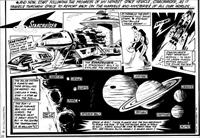
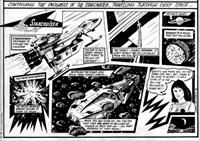
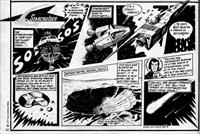
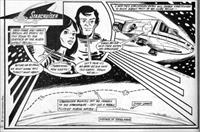
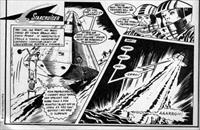
Having produced the comic for nearly 2 years by the time the Airfix kit came out, David Jefferis designed the cover art and did a short strip for the instruction leaflet.
When the Space City exhibition opened in Blackpool, it included Martin Bower's "Starcruiser 3" model and art from Look-In. David Jefferis was commissioned to draw larger drawings of Starcruiser for the exhibition.
In Starlog#21 (1979), Gerry Anderson described how the concept had been pitched to Airfix. He doesn't mention the Freiberger TV proposal. He mentions they are talking about Starcruiser 2.
The story concept is updated, taking elements from David Jefferis, updated with new characters. The text was written by Starlog writer David Hirsch. The Starcruiser 1 craft was to be operated in the year 2051 by "Interstellar Command" - a quasi military organisation simultaneously acting as a police and exploration group (along the lines of Star Trek's Starfleet). Starcruiser 1 would have been based in the "Capricorn-Antilles Space Habitat" reporting to commander Edward Damion. The original Starcruiser 1 crew consisted of four astronauts: captain Christopher Stevens, navigator/astrophysicist lt. Andrea Dehner, medical officer Dr.Brian Moore and technical officer prof. Melita Alterra (who also designed the ship itself).
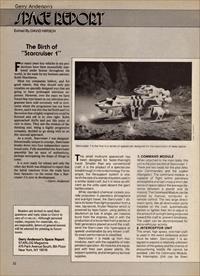
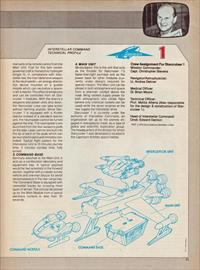
Sources:
Copyright Martin Willey